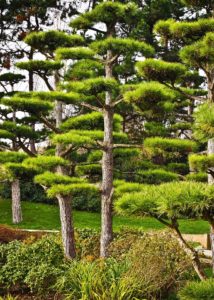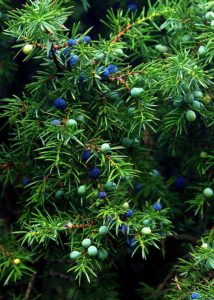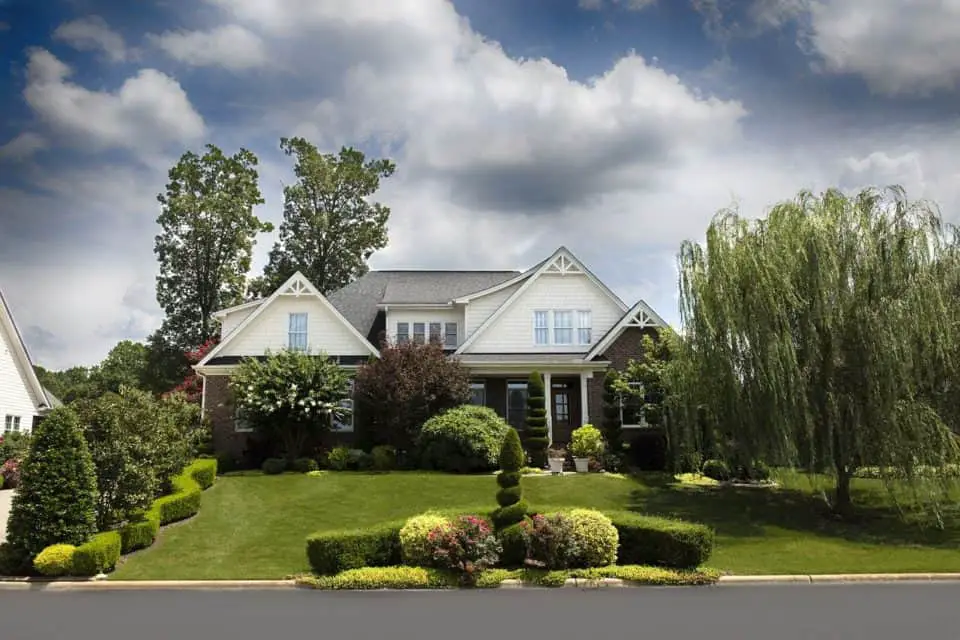Some links in the post are affiliate links and I get a commission from purchases made through some links found in the post.
Shrubs play a vital role when it comes to landscaping the front of your lawn.
They provide the foundation to your whole garden and help to fill out all the dull spots.
With most people stepping onto your property, the first thing they will notice is the garden so you would love for it to be eye catching.
Therefore, careful selection is needed to bring the most out of your space. But with a wide variety of available choices, novice gardeners are often confused about what to plant.
To take care of this problem, it would help to get a visual image of what kind of lawn you would like.
It’s best to have evergreen shrubs as the foundation for the curb to look attractive all year-round. They are low maintenance and keep the garden interesting at all times.
On the other hand, the flowering shrubs can be a little demanding when it comes to their care. They only look good for 2 or 3 weeks when in bloom.
Instead of using them as the main foundation plants, you can try to mix and match with them which will help light up your porch in the springs.
7 Best Shrubs to Plant in Front of House
The following list of 7 great shrubs to plant in front of your house can help you create an impressive front lawn.
Most of them are easy to take care of so don’t have to worry about them all the time.
1) Boxwood
Boxwoods are excellent evergreen shrubs and are very commonly used by landscapers.
They maintain their fresh color all year-round and their oval glossy leaves make them look all the more attractive.
The most common variety used is the Boxwood ‘Winter Gem’ (Buxus microphylla).
Pros:
They are very easy to prune and grow wonderfully in every condition.
Their slow growth makes them very containable and can flourish in both ground and containers.
Boxwoods are also very drought tolerant and can grow equally well in partial or full sunlight.
Cons:
Boxwoods are resistant to most pests but can be affected by leaf miners and mites sometimes.
Other than that, boxwood blight can quickly ruin your hedges if it isn’t controlled in the first place.
2) Euonymus
Euonymus has about 175 different varieties. The most commonly known is the “burning bush”.
This evergreen variety is rapidly growing and can be perfectly manicured into beautiful hedges. It is particularly adored for its leathery small leaves
Pros:
They are really easy to grow and can be molded into any shape that is required. They can be either used as hedges or creating beautiful topiaries.
Cons:
As these are rapidly growing plants, they need regular pruning. They can quickly go out of form if you forget to prune them regularly.
3) Japanese Yew
 Yews are a very popular choice for borders and entryways. They provide dense and evergreen foliage and keep the lawn looking fresh at all times.
Yews are a very popular choice for borders and entryways. They provide dense and evergreen foliage and keep the lawn looking fresh at all times.
The Japanese yew look amazing at any height and fits comfortably in any sized gardens.
They grow well in most soil conditions and prefer areas with partial shade to medium sunlight.
Pros:
Due to their dense foliage, they are used a lot as privacy hedges. They are very low maintenance and are easy to prune.
They can withstand hard pruning and can be cut into any shape desired. Apart from that, they are long-lasting and can survive years without taking a significant toll on their health.
Cons:
They are slow-growing as compared to other shrubs and can take time to attain height.
They bear small red berries in the spring which look beautiful but can prove to be a menace when they attract a lot of birds.
And apart from that, all the parts of the plants contain a high amount of alkaloids which are poisonous to both humans and animals.
You may also like: What are the best trees to plant near your house for shade
4) Gold Thread Cypress
This evergreen shrub has drooping branches with scale-like foliage. It has a mounding growth habit that can be kept lower by regular pruning.
The plant displays its full grandeur when planted in full sunlight. Its rich gold color makes it a wonderful choice to be used as an accent plant.
Pros:
If you are looking for a plant that can fit small gardens, then this is your best bet. It requires very little maintenance and can tolerate drought conditions easily.
Cons:
It is a very slow-growing plant and can take almost twenty years to reach its mature size.
It can attain a maximum height of 6 feet after this period. Also, the plants spread a lot sideways and should not be planted along pathways or driveways.
5) Wax Myrtle
Wax myrtle (Myrica cerifera) is a fast-growing evergreen hedge that makes an excellent addition to the landscape.
This plant is quite hardy and can endure a variety of soil conditions.
Pros:
Due to their fast growth, they are extensively used as privacy screens for homes.
They also produce small berries that provide food for birds in the winter, so you can also enjoy birdwatching alongside them.
Their leaves are quite fragrant and make them a good choice for entrances and driveways.
Cons:
These plants have trouble growing alongside annual or perennials due to root damage.
Root disturbance or injury results in the growth of suckers as a protective response that must be pruned out to keep the plant in good shape.
6) Rose Bushes
Rose bushes are favorites when it comes to being used as foundation plants for your front porch.
They prove to be a wonderful combination with evergreen shrubs. Their fragrant and showy flowers make the hedges look even more colorful.
Pros:
They are relatively low maintenance as compared to other flowering shrubs and can grow in most soil conditions.
Cons:
Pruning roses is a bit challenging for new gardeners. Managing the prickly bushes can be cumbersome for most people.
7) Blue Star Juniper
Blue star junipers are excellent shrubs for adding color contrast to the line. They make an excellent pair with gold threadleaf cypress and other accent plants.
Their evergreen nature makes them never go out of style. Also, their slender leaves and stems look really unique.
The awl-shaped foliage provides an interesting texture in the garden.
Pros:
This variety of juniper grows very slowly. Therefore, it’s an ideal choice for foundation planting in small gardens.
Cons:
This plant has a growth spurt many years after its plantation.
This can cause an unwanted increase in height and may mess up the orientation of your lawn. So they should be planted in relatively spacious areas.
Can Shrubs Damage Foundations?
The shrubs mentioned in the list are very innocuous and tend to remain in their place. They are not as invasive when compared to fast-growing trees.
But they can present you with problems especially when they are planted too close to the house. Some plants have strong and persistent roots that can impinge on the foundation.
They can weaken the foundation by drying the soil and allowing water to seep below. This leads to leaky basements and cracks in driveways.
How Far Should the Shrubs Be from Your Home?
 It’s best not to randomly plant the shrubs anywhere on your lawn. A fine space should be present between your house and the plants.
It’s best not to randomly plant the shrubs anywhere on your lawn. A fine space should be present between your house and the plants.
This is to prevent any damage to the foundation and exterior walls. Proper spacing not only saves your house from harm, but also allows your plants to grow without crowding.
Every plant is different and the growth potential for each of them is variable. So when choosing a location to plant, always have the mature size of the plant in your mind.
Small shrubs can easily be planted at least 2 feet from the foundation. Medium and tall shrubs require a gap of at least 4 to 6 feet to avoid them coming in contact with the roof’s eaves.
How Tall Should the Shrubs Be in Front of the House?
When landscaping, an inverse approach is used i.e. the taller plants are placed on the back with the shorter ones on the front.
This applies well to when you plant your shrubs in the front of your house. This not only makes your front look symmetrical, but also provides plenty of access to trim the plants.
The ideal height of the shrubs should be 6-8 feet. Anything more than this may look unsightly.
Final Thoughts: Top 7 Shrubs to Plant in Front of Your House
If you are looking for privacy, then fast-growing shrubs like wax myrtle can be used that completely block the view of your home.
Using a mix of different types of shrubs, you can create a perfect combination that suits your style.
Before you go, here are some more related articles I encourage you to read below to help solve more of your gardening issues:
How to Landscape with Hydrangeas
What Are the Fastest Growing Evergreen Trees for Small Gardens
How Long Do I Have To Wait Before Planting After Stump Grinding
About the Author:
Saad Ansar
Saad is an avid gardener himself and is a great lover of plants, animals, photography, & people. Currently, he is focused on photographing indoor plants & captioning beautiful outdoor sceneries. He writes and rewrites in-depth articles on nature and science.

